By Kent R. Kroeger (Source: NuQum.com; May 10, 2021
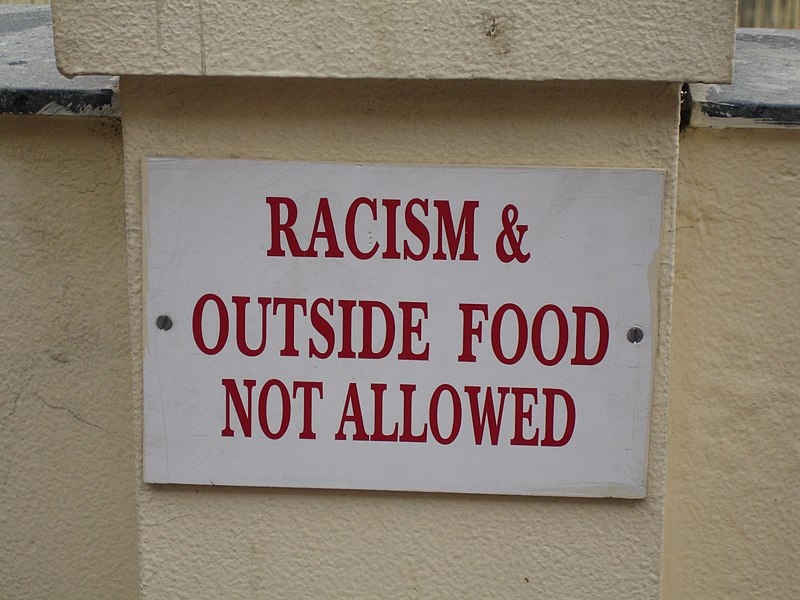
“If you can’t measure it, you can’t improve it.” — Peter Drucker
“One can ignore reality, but one cannot ignore the consequences of ignoring reality.”— Ayn Rand
Since my days as a young grad assistant in the late 1980s, I have periodically worked in and around the social science debate on the best methods for measuring racist attitudes and behaviors in the U.S.
With respect to racial attitudes, in particular, I have encountered two main schools of thought. The first school believes we can ask people directly about their feelings on race and ethnicity and receive substantively unbiased answers (in the statistical sense of bias). While people are capable of hiding their true feelings on sensitive subjects (i.e., the social desirability bias), if the research study is well-designed and protects anonymity, people will answer questions on socially sensitive issues with surprising honesty, according to this school of thought.
The second school is not as sanguine. In their view, people are captive to their desire to leave a favorable impression with others and will try to avoid being classified as a ‘racist’ or ‘bigot.’ Thus, people will modify their responses on opinion surveys regarding racial attitudes to avoid such pejorative labels. In other words, researchers can’t simply ask people what they think on race, but must employ indirect methods for assessing an individual’s true racial attitudes (such as randomized response techniques).
While I am sensitive to the concerns of the second school, in practice I have found simple, direct questions on race and ethnicity to consistently reveal substantive differences in racial attitudes among U.S. adults. [An excellent research summary on these two school of thoughts can be found here. I also covered this research controversy in a previous Medium.com essay.]
With this caveat in mind, here are results from one of the latest research studies on U.S. attitudes regarding race and ethnicity, collected by researchers from Stanford University and the University of Michigan in the 2020 American National Election Study (ANES).
Racist attitudes are not just a Republican problem
The 2020 ANES administered a series of thermometer scales (0 to 100) to assess respondents’ favorability towards four specific race and ethnic groups (Whites, Blacks, Hispanics and Asians):
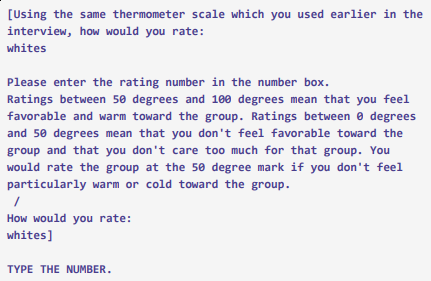
How does someone answer a question like this if they consciously refuse to judge anyone based on their race or ethnicity? As it turns out, about 15 percent of all respondents (out of 7,453 respondents to the post-election wave of the 2020 ANES) rated the four racial and ethnic groups as a ‘50.’ Some other respondents rated the four groups as equal at a different point on the scale. For example, nine percent of respondents rated all four groups a ‘100’. [Eight people rated each of the four race and ethnic groups a ‘0’!]
In total, 51 percent of U.S. eligible voters rated their own race/ethnicity as equal (or below) the other three race and ethnic groups (I label these respondents as “Racial Neutralists”). Another 34 percent of eligible voters rate their race or ethnic group higher than at least one other race or ethnic group (I label them “Racial Chauvinists”).
Lastly, an additional 16 percent of respondents either refused to answer the race/ethnicity favorability question for their own race/ethnic group or were from a race/ethnic group (e.g., Native American and multi-race respondents) where favorability ratings for their group were not asked (I label these respondents as “Unclassifiable”).
The number that seems to shock those I’ve shared this data with is the 34 percent of U.S. eligible voters who openly admit they harbor some level of racial or ethnic bias.
My wife’s initial reaction was to say, “They must be Trump Republicans.” — a reaction that was not unique. After analyzing 100 30-second news clips broadcast on CNN and MSNBC between May 1, 2020 and May 1, 2021 (the GDELT-archived clips can be found here), every single one explicitly connected racism to either Donald Trump supporters, conservatives, Republicans or white supremacists within those groups.
Is racism, in fact, mostly a Republican or white conservative problem?
Well, it depends on how you define mostly.
As Figure 1 shows, the percentage of racial chauvinists isbasically identical within the Biden and Trump voter bases (33.1 percent and 33.6 percent, respectively). Likewise, slightly over half of Biden and Trump voters can be categorized as racial neutralists. In contrast, third party voters are significantly less likely to be racial chauvinists (21.6 percent).
Figure 1: Racial/ethnic bias within the 2020 U.S. electorate (by presidential candidate)

How can that be true? Did the Trump voters lie on the ANES survey?
Relax my resistance friends. The news isn’t entirely positive for Trump Republicans.
If we examine the 2020 electorate by their race/ethnicity, a more familiar picture of racial bias emerges. Figure 2 indicates that 29.1 percent of Trump voters are white racial chauvinists (i.e., rated Blacks, Hispanics, and/or Asians below Whites on a 100-pt. favorability scale), compared to only 10.5 percent of Biden voters. In other words, Trump voters are three times more likely than Biden voters to be white and a racial chauvinist.
At the same time, Biden and Trump voters are equally likely to be white and a racial neutralist (42.0 percent and 47.5 percent, respectively). That is to say, if you were to randomly draw one Trump voter and one Biden voter from their respective populations, you would have an equal chance in each case of drawing a white person with no (self-reported) racial bias.
Figure 2: Racial/ethnic bias within the 2020 U.S. electorate (by presidential candidate and eligible voter’s race/ethnicity)
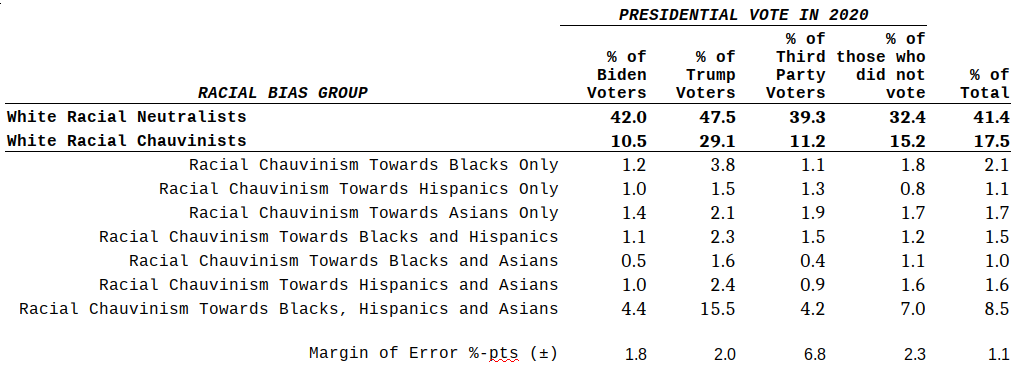
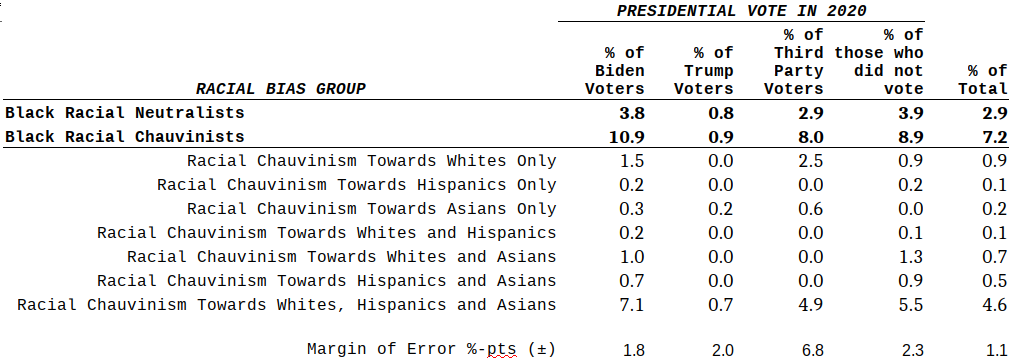
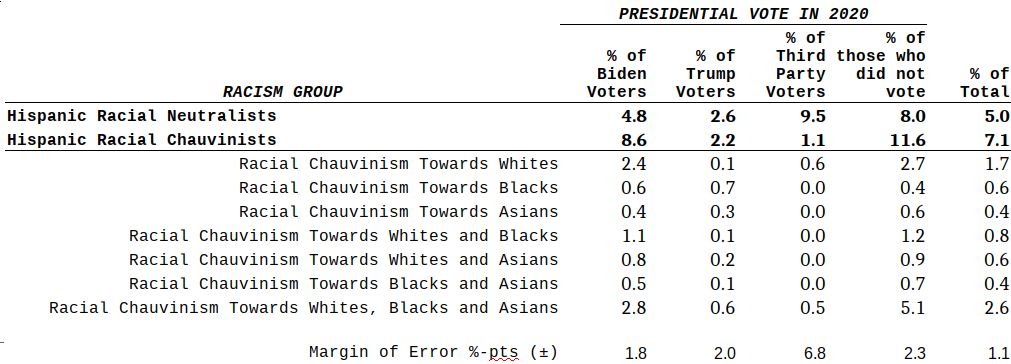
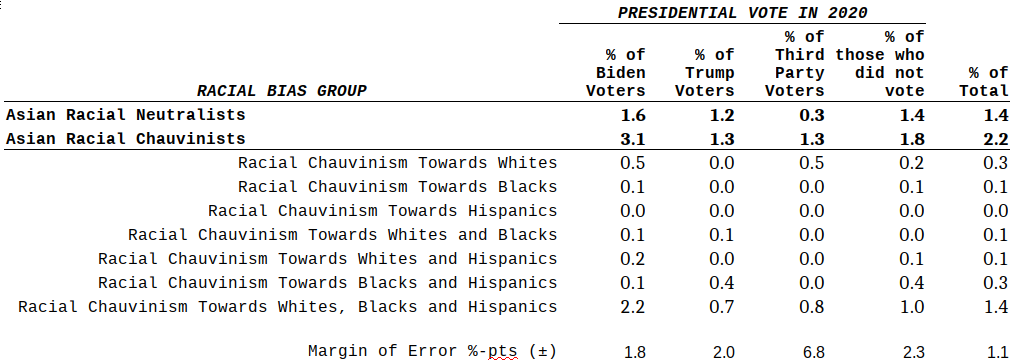
So, while a Trump voter is significantly more likely to be a white racial chauvinist than a Biden voter, when one adds the Black, Hispanic and Asian voters who are racial chauvinists to the mix, the percentage of Biden voters who are racial chauvinists turns out to be virtually the same as for Trump voters (i.e., about one-third).
Figure 3 reveals the issue. The reality is that over half of Black, Hispanic, and Asian Americans hold racially-biased attitudes towards other races and ethnicities (63.3 percent, 54.1 percent, and 57.8 percent are racial chauvinists, respectively). In contrast, only 26.7 percent of whites are racial chauvinists.
Figure 3: Racial/ethnic bias within the 2020 U.S. electorate (by eligible voter’s race/ethnicity)
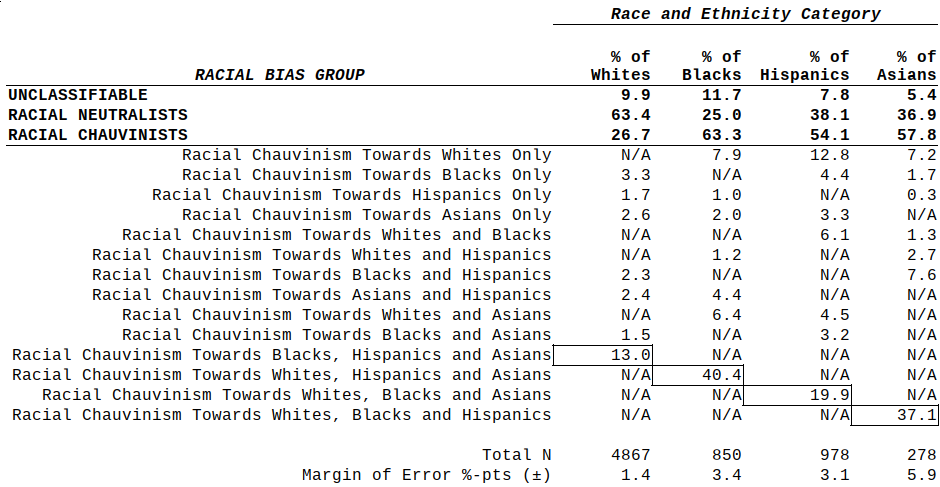
Even if we remove racial biases against whites from the equation, 55.4 percent of Black Americans possess racial biases against Hispanics and/or Asian Americans. Similarly, 41.3 of Hispanics and 50.6 percent of Asians hold racial biases against the other non-white racial and ethnic groups.
Judge not, that ye be not judged (Matthew 7:1)
There is a compelling argument within the racism-focused academic and activist communities that says Black Americans (and racial/ethnic minorities, in general) can’t be racist because racism requires a “power-over” relationship. Writes pastor and anti-racism activist Joseph Barndt:
“Racism goes beyond prejudice. Racism is the power to enforce one’s prejudices. More simply stated, racism is prejudice plus power.” [Dismantling Racism: The Continuing Challenge to White America (Minneapolis, 1991), 28.]
One reason I prefer the label ‘racial chauvinism’ to that of ‘racism’ in this essay is that the 2020 ANES survey items I use here are attitudinal measures, not behaviors. Thus, I use terms like chauvinism, prejudice, or bigotry as attitudinal indicators and reserve terms like racist or racism for the active implementation of prejudiced attitudes.
I acknowledge this may be pure semantics, but I have found this distinction useful in the past when analyzing racial bias, particularly in the context of survey-based data.
In the end, I am sympathetic to the argument that a white racial chauvinist generally occupies a different position in our society than a Black, Hispanic or Asian racial chauvinist;and, therefore, should not be treated as a substantive or operational equivalent.
Combined with institutional racism and demographic size disparities, white racial chauvinism is substantively more impactful in the aggregate.
Nevertheless, it is also wrong to ignore racial and ethnic prejudice existing within the non-white communities making up the Democrats’ electoral coalition.
Racial scholar Lawrence Blum, Professor of Liberal Arts and Education at the University of Massachusetts, concludes:
“Contemporary use of the vocabulary of racism no longer confines it to whites; Chinese, blacks, Japanese, Latinos, and other people of color are recognized to include in their ranks racially bigoted persons and, more broadly, to be subject to racial prejudices. These attitudes can be directed toward other groups of color, toward whites, or toward members of one’s own group. People of color are also capable of developing belief systems based on racial superiority, in which some groups of color are superior and whites or other groups of color are inferior…In my view, these attitudes and beliefs are all racist, and current usage generally so refers to them.”
Highlighting some sources of racial bias and prejudice while ignoring others is most likely not helpful in the long run and, frankly, paints a distorted picture of reality.
As such, media-driven tropes about the alleged tolerance within Republican ranks for ‘white supremacists’ are not just inaccurate, they are counterproductive if our goal is to achieve lasting progress in U.S. racial relations.
Given that 10 percent of Biden’s voter support in 2020 came from white chauvinists, it is time for Democrats to stop pretending the racial bias problem is isolated to Donald Trump supporters.
It is not.
- K.R.K.
Send comments to: nuqum@protonmail.com
All data and SPSS computer programs used in writing this essay are available on GITHUB ==> HERE.